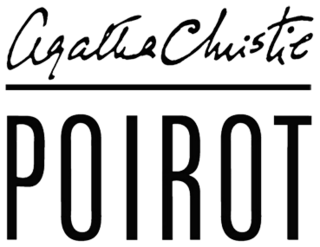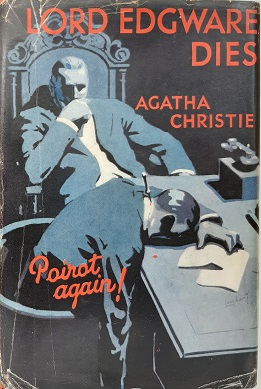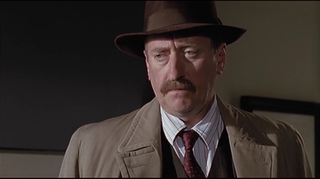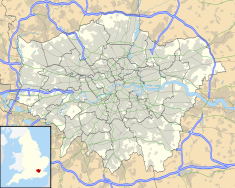
Hercule Poirot is a fictional Belgian detective created by British writer Agatha Christie. Poirot is one of Christie's most famous and long-running characters, appearing in 33 novels, two plays, and more than 50 short stories published between 1920 and 1975.

Murder on the Orient Express is a work of detective fiction by English writer Agatha Christie featuring the Belgian detective Hercule Poirot. It was first published in the United Kingdom by the Collins Crime Club on 1 January 1934. In the United States, it was published on 28 February 1934, under the title of Murder in the Calais Coach, by Dodd, Mead and Company. The UK edition retailed at seven shillings and sixpence (7/6) and the US edition at $2.

Poirot is a British mystery drama television programme that aired on ITV from 8 January 1989 to 13 November 2013. David Suchet starred as the eponymous detective, Agatha Christie's fictional Hercule Poirot. Initially produced by LWT, the series was later produced by ITV Studios. The series also aired on VisionTV in Canada and on PBS and A&E in the United States.

Lord Edgware Dies is a work of detective fiction by British writer Agatha Christie, published in the UK by the Collins Crime Club in September 1933 and in the US by Dodd, Mead and Company later in the same year under the title of Thirteen at Dinner. Before its book publication, the novel was serialised in six issues of The American Magazine as 13 For Dinner.

Captain Arthur J. M. Hastings, OBE, is a fictional character created by Agatha Christie as the companion-chronicler and best friend of the Belgian detective, Hercule Poirot. He is first introduced in Christie's 1920 novel The Mysterious Affair at Styles and appears as a character in seven other Poirot novels, including the final one Curtain: Poirot's Last Case (1975), along with a play and many short stories. He is also the narrator of several of them.

Inspector James Japp is a fictional character who appears in several of Agatha Christie's novels featuring Hercule Poirot.

Dead Man's Folly is a work of detective fiction by Agatha Christie, first published in the US by Dodd, Mead and Company in October 1956 and in the UK by the Collins Crime Club on 5 November of the same year. The US edition retailed at $2.95 and the UK edition at twelve shillings and sixpence (12/6). It features Hercule Poirot and Ariadne Oliver.

Murder on the Orient Express is a 1974 British mystery film directed by Sidney Lumet, produced by John Brabourne and Richard Goodwin, and based on the 1934 novel of the same name by Agatha Christie.

The Alphabet Murders is a 1965 British detective film directed by Frank Tashlin and starring Tony Randall as Hercule Poirot. It is based on the 1936 novel The A.B.C. Murders by Agatha Christie.

Agatha Christie: Murder on the Orient Express is a 2006 adventure game developed by AWE Productions and published by The Adventure Company for Microsoft Windows. It is the second installment in The Adventure Company's Agatha Christie series. The setting is five years before the events in Agatha Christie: And Then There Were None, with a largely unrelated storyline. The plot follows an amateur sleuth, Antoinette Marceau, and her investigation of a murder with twelve possible suspects aboard the Orient Express, which has been blocked by an avalanche in the Kingdom of Yugoslavia during 1934. She is aided by famous detective Hercule Poirot.

Agatha Christie's Marple is a British ITV television programme loosely based on the books and short stories by British crime novelist Agatha Christie. The title character was played by Geraldine McEwan from the first to the third series, until her retirement from the role, and by Julia McKenzie from the fourth series onwards. Unlike the counterpart TV series Agatha Christie’s Poirot, the show took many liberties with Christie’s works, most notably adding Miss Marple’s character to the adaptations of novels in which she never appeared. Following the conclusion of the sixth series, the BBC acquired the rights for the production of Agatha Christie adaptations, suggesting that ITV would be unable to make a seventh series of Marple.

Claude Austin Trevor Schilsky was an Irish actor who had a long career in film and television.

Thirteen at Dinner is a 1985 British-American made-for-television mystery film featuring the Belgian detective Hercule Poirot. Adapted by Rod Browning from the 1933 Agatha Christie novel Lord Edgware Dies, it was directed by Lou Antonio and starred Peter Ustinov, Faye Dunaway, Jonathan Cecil, Diane Keen, Bill Nighy and David Suchet, who was later to play Poirot in the long-running television series entitled Agatha Christie's Poirot. The film first aired on CBS Television on October 18, 1985.

Campden Hill is a hill in Kensington, West London, bounded by Holland Park Avenue on the north, Kensington High Street on the south, Kensington Palace Gardens on the east and Abbotsbury Road on the west. The name derives from the former Campden House, built by Baptist Hicks, 1st Viscount Campden whose country seat was Campden House in the Gloucestershire town of Chipping Campden.

Alibi is a 1931 British mystery detective film directed by Leslie S. Hiscott and starring Austin Trevor, Franklin Dyall, and Elizabeth Allan.

Lord Edgware Dies is a 1934 British mystery film directed by Henry Edwards and starring Austin Trevor, Jane Carr, and Richard Cooper. The film was based on the 1933 Agatha Christie novel Lord Edgware Dies.

Addison Road is a road in London, England, which connects Kensington High Street with Notting Hill and Holland Park Avenue and runs nearby to Holland Park.
In Agatha Christie's mystery novels, several characters cross over different sagas, creating a fictional universe in which most of her stories are set. This article has one table to summarize the novels with characters who occur in other Christie novels; the table is titled Crossovers by Christie. There is brief mention of characters crossing over in adaptations of the novels. Her publications, both novels and short stories, are then listed by main detective, in order of publication. Some stories or novels authorised by the estate of Agatha Christie, using the characters she created, and written long after Agatha Christie died, are included in the lists.
Lists of adaptations of the works of Agatha Christie:
Hercule Poirot is a series of full cast BBC Radio drama adaptations of Agatha Christie's Hercule Poirot novels and short stories adapted by Michael Bakewell, broadcast on BBC Radio 4 between 1985 and 2007. With the exception of the first two adaptations, the series stars John Moffatt as Poirot.


















